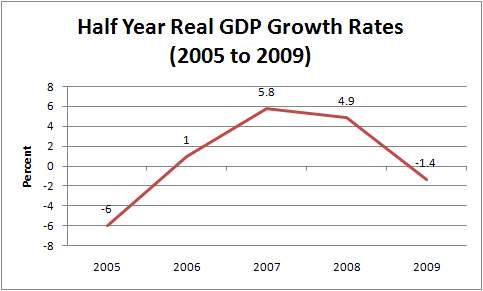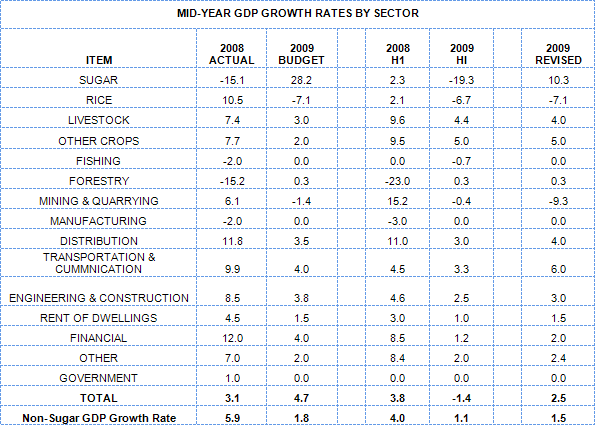Today Business Page begins a short series on the Mid-year Report 2009 which the Minister of Finance is required to submit to the National Assembly under the Fiscal Management and Accountability Act, 2003.
Introduction
Despite the President’s assurance that he had constructed a “firewall” – a term used to refer to the prevention of unauthorised intrusion into a computerised system – to protect the economy from the recession which had hit the world economic system, the Guyana economy contracted by 1.4% during the first half of 2009 (H/Y). This is according to the mid-year report presented to the National Assembly by Dr Ashni Singh, Minister of Finance on November 12, 2009, more than ten weeks after its legal due date and five days after this column had lamented the financial lawlessness that now characterises the Jagdeo/Singh economic management team. The firewall was only able to promote and permit growth in the half-year in two of the fifteen economic sectors when compared with their performance in the first half of 2008. The sectors which show improvement being forestry which grew in H/Y 2009 by 0.3% compared with a decline of 23% in the corresponding period in 2008, and manufacturing which moved from a decline of 3% in H/Y 2008 to 0% in the same period in 2009. Although the great majority of sectors performed poorly, the Minister of Finance who also controls the Bureau of Statistics which compiles the national statistics constituting his report, reported half-year growth in the non-sugar sector of 1.1% compared with a 4% growth for the same period in 2008. As Bill Clinton would say, It’s sugar, Stupid.
Obviously disregarding current developments in the sector, the report projects sugar to boost overall economic performance in the second half of 2009, reversing its own 20% decline in half-year 2009 to a 10% overall 2009 growth, and thereby spectacularly transforming the economy’s half-year decline of 1.4% to a full year 2.5% growth for the entire year. Once again, the Bureau of Statistics will have its work cut out, but more significantly, despite the government’s two-decade attempt at diversification of the economy, sugar remains the economy’s backbone, lifeblood, and increasingly its scapegoat. The projected growth in sugar and therefore the rest of the economy must be encouraging for the main sugar union GAWU as it enters into government-imposed wages arbitration with the state owned GuySuco.

Source: Minister of Finance Mid-Year Report 2009
And even the improved performance in the two sectors may not bode too well after all. Under the Guyana-Norway LCDS Memorandum of Understanding (MOU) addressed in this column last week, the country may not be able to optimally exploit our forested areas that cover 80% of the country. That understanding brings those areas under international supervision bordering on control, in return for a six-year grant from the Norwegians of potentially US $250 million – hardly a good return on what President Jagdeo has described as our greatest asset. Because the report was said to have been written before the signing of the MOU, it does not contain any reference to that agreement, including the immediate potential implications. Hopefully, that is not overlooked as the Guyana-Norway agreement is for specified funds for a limited period.
With respect to manufacturing, let us recall that the explanation given by the Minister last year for the manufacturing sector recording what economists like to refer to as negative growth, was partly the high cost of inputs – fuel and imported raw materials. The question whether the manufacturing sector is a mere price taker would be very interesting indeed for consideration by the Minister of Finance, the leaders of the sector and those who continue to call for any and every tax concession ever conceived. It must also be of some irony and concern that the Vice-Chairman of the Private Sector Commission and a lead private sector person on the Jagdeo-led National Competitiveness Strategy Programme, Mr Ramesh Dookhoo, is the current head of the Guyana Manufacturers Association.
It is surely not too early to ask President Jagdeo and Mr Dookhoo to show how the over five-and-a-half billion dollars borrowed from the IDB are benefiting the country, in the light of the reverse-stop-go performance of the economy. Just to put Norway’s potential contribution into context, the NCS loan is 90% of the first year LCDS payment. I do not know if the lender, the IDB pays any attention to the work done by the National Competitiveness Council but what is on the NCS website is what one would hardly expect from busy politicians and their overpaid consultants and experts.

Source: Mid-year Report 2009
As usual the report does not bother to deal with several key issues relevant to the economy and the only mention the Clico fiasco warrants is a boast that “the government’s timely intervention in placing the company under judicial management has helped to contain the impact of the company’s difficulties.” It does not appear to have been recognised or accepted that had the government’s intervention been before and not after the virtual collapse of the company’s Trinidad parent, then the country would not have lost a gross sum of tens of millions of US dollars. The report offers no assurance of when Clico’s depositors and policy-holders will receive the money guaranteed by the ever-promising President. Those include the National Insurance Scheme and thousands of others who did not benefit from the serendipitous payout by Clico just prior to its downfall. Nor does it address the new arrangements for the insurance sector that has now been placed under the Bank of Guyana, the very institution that along with the Office of the Commissioner of Insurance contributed in no small measure to the demise of Clico. It is timely to note as well that the hurriedly drafted amendment is likely to create more juridical problems than the administrative weaknesses it is intended to cure. The entire functions of the Commissioner of Insurance have been transferred to the Bank of Guyana and unless the bank creates a similarly named position it is a fair inference that the position has been abolished.
It would have been good too if the Minister had spent some time telling the country about the state of tax reform which has become another annual promise, the progress to stem money-laundering, the state of the National Insurance Scheme given its exposure to Clico, legislation dealing with the New Building Society that according to the President has reached its lending limit, the (President’s) $2 billion promise to the housing sector for the vulnerable groups in our society and his billion dollar mangrove project and Dr Singh’s understanding of the reasons for the sharp decline in the performance of the distribution sector, from 11% in both halves of 2008 to a mere 3% in half-year 2009. Or is it that the Minister considers this and the reported Bureau of Statistics’ “estimate” of inflation in half year 2009 of 1.3% adequately dealt with by his assessment of consumers’ exercise of “caution and prudence”? I have to confess that is a novel if not unique explanation for depressed spending power in the national economy.
To be continued
